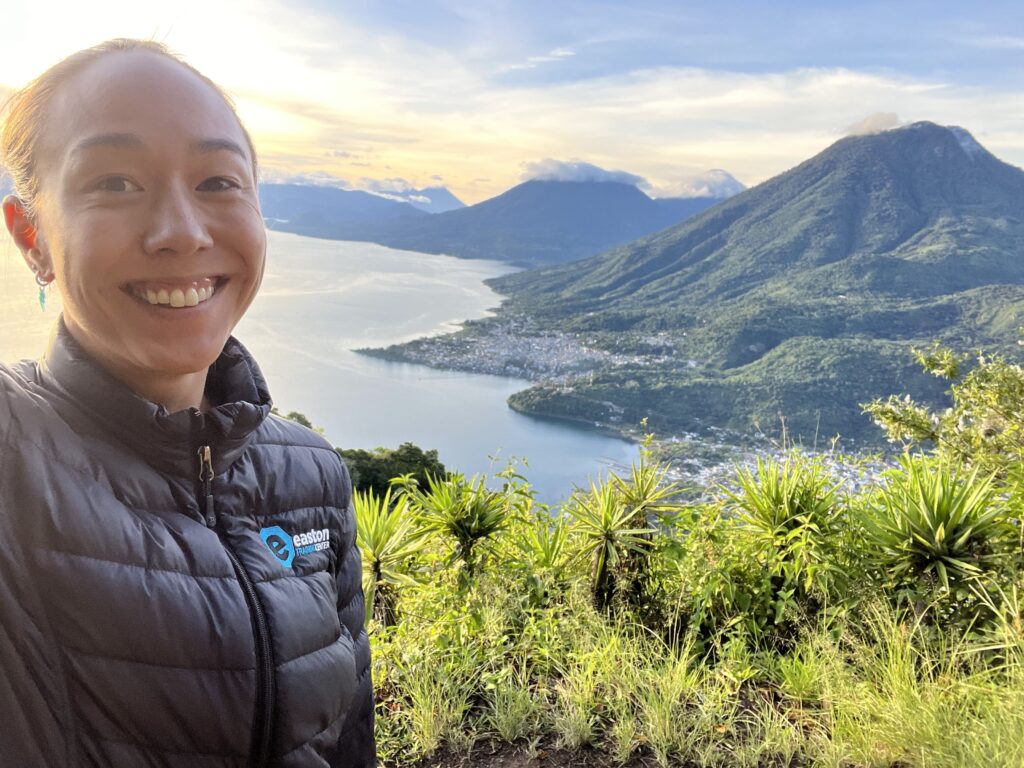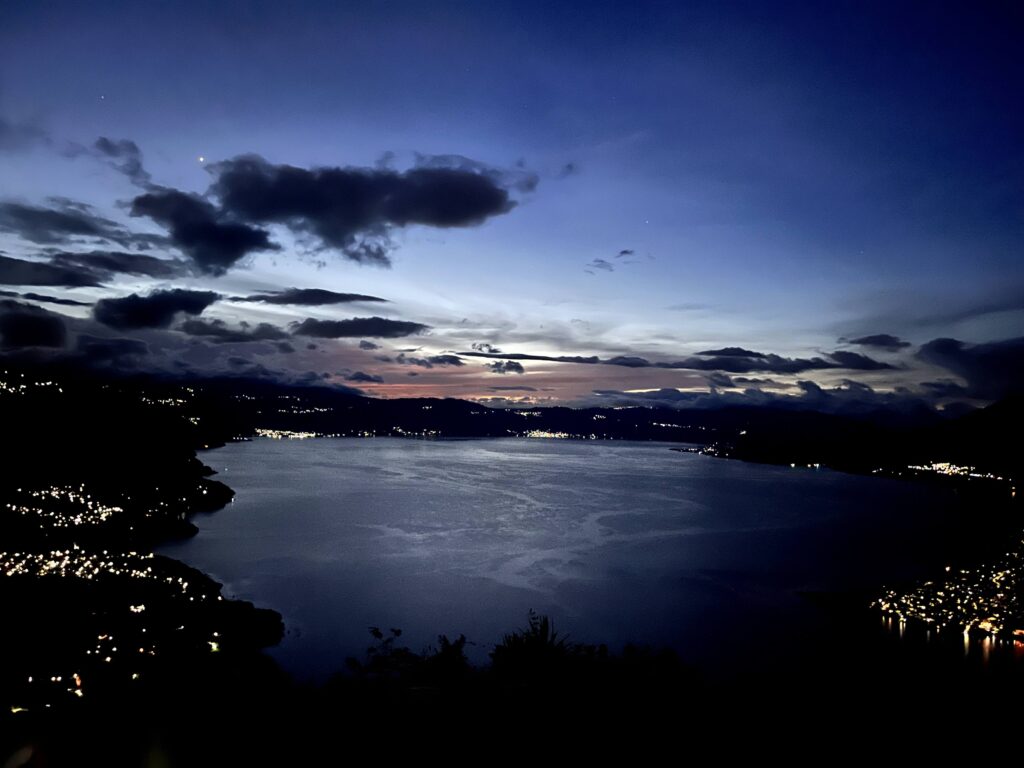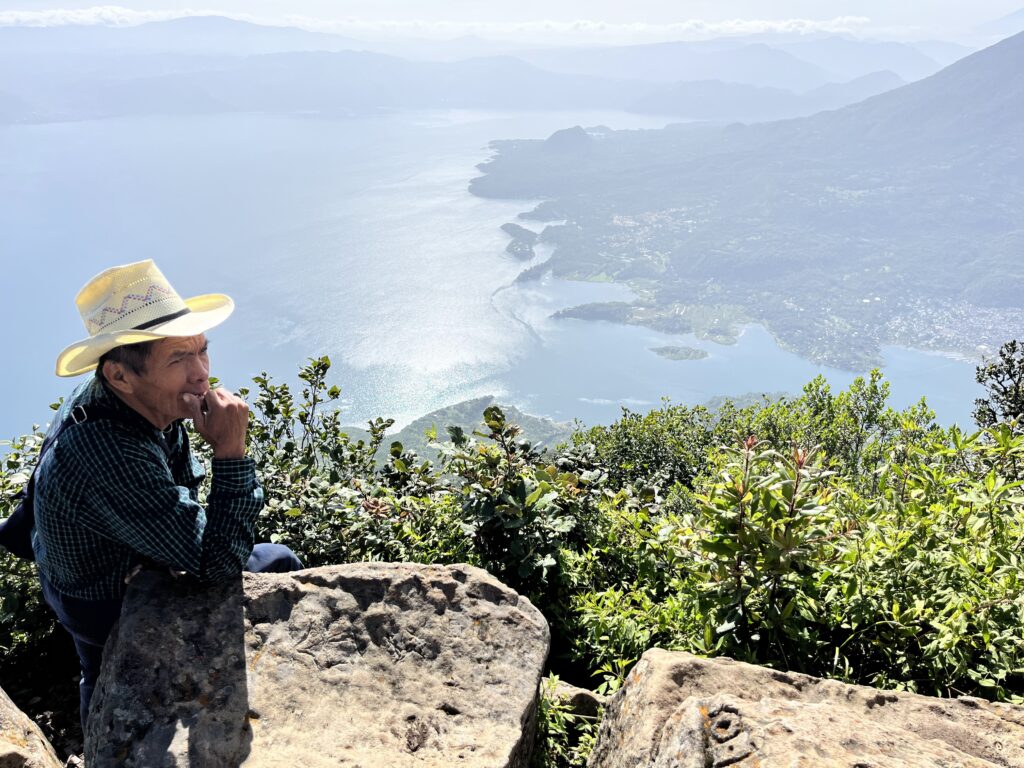Lago Atitlán
Before I decided where to begin my travels, I was doing some research, and I came across photos of Lake Atitlán in Guatemala. Between the jaw-dropping scenery, and the reasonable pricing of Spanish language schools, I quickly decided that Guatemala was my destination.
After Antigua, I took a shuttle to the large crater lake, which is surrounded by steep, extinct volcanoes. Surrounding the lake are 11 towns, each with its own distinct character. The easiest way to travel between the towns is by lancha, a small motor boat. For a nominal fee, you can buy passage on what is essentially a water bus, which stops briefly at each town along the lake shore.
I spent a week attending San Pedro Spanish School in the small town of San Pedro La Laguna. San Pedro has a reputation as a backpacker’s partying paradise, with several party-focused hostels along the “main drag” near the docks. But I had just recovered from COVID, was living with a family, and I had early morning Spanish lessons, so partying wasn’t on the agenda. Instead, I prioritized resting and getting outside.
Rostro Maya

The most well-known hike in the area is the Rostro Maya, AKA “Indian Nose,” so named because the section of the mountain that you climb looks like the face of a reclining person. The popular thing to do is book a tour that departs around 4:00 AM, and watch the sunrise from one of the viewpoints up top. I booked said tour, and found myself on a packed shuttle bus riding up switchbacks in the dark.
We got out of the van and met our guide, a small, middle-aged guy with a bright demeanor, a big tote bag, and a machete. I asked about the machete because I’d heard that some of the hikes in the area had been plagued by robberies in recent years, which is why it’s recommended to enlist a guide for most hikes. He assured me it was for plants, not bandits. We walked in the light of the full moon, through some flat farmland, and eventually up a steep but well-established path. The actual climbing part was brief, maybe 20 minutes. We arrived at a big wooden platform, where we could see the lights of towns across the way shimmering over the black, glassy lake.
As the moon set behind us, we started to see a faint brightening behind the mountains in the east. Our guide made us coffee from water and ground that he’d carried up the hill, and we sipped. San Pedro is apparently a hotspot for Israeli travelers (to the point where there are some business signs in Hebrew), and there were several Israelis in the group. One Orthodox Jewish guy from the US performed his morning prayer rites facing the sunrise over the lake. It seemed like a pretty spectacular place to give thanks for life and for the beautiful world, and I think we were each doing that in our own way as little by little, we watched the day emerge.

Volcan San Pedro
The town of San Pedro gets its name from the extinct volcano that sits beside it, steep conical, and covered in greenery. I wanted to climb it. Volcán San Pedro is a much harder hike than Rostro Maya, and it turned out to be a lot harder to find a tour company that was running any hikes. I went up and down the touristy main street along the lakeside edge of town, asking at all the tour companies (there are many), and only found two that said I would be able to book something for that weekend. I chose the cheaper one (after having learned that everybody in my Rostro Maya group had booked with different tour agencies and paid different prices and we all ended up on the same bus). It was another early start, 6:30 AM, but I knew it would be a bigger hike, so good to get going before the sun got too hot.
I set out in the early morning light with my daypack loaded up with a banana, some nutella toast from Lupe, When I arrived at 6:30, the guy at the tour agency said that there was someone else who had booked the hike, and they’d be coming at 7:30, and would I mind waiting? Yes, I would. I did not get up at 5:45 to sit in this office for an hour. I didn’t say it that way, but I made my point, and he called for my guide and my tuktuk ride, and after about 20 minutes, we were off.
We arrived at the trailhead, which is a protected park. As we started hiking, I chatted with my guide Nicolas, practicing my Spanish, asking him about his family and his work. Nicolas told me that he’d been working as a guide hiking this volcano for about 15 years, and before that, there wasn’t really any demand for tourists hiking up here. There wasn’t a trail. He told me he was 67, with a wife, two grown children and a couple of grandchildren, all of whom also lived in San Pedro.
We hiked past coffee plants, and I asked him if anybody was caring for them, and he said yes, but that these ones don’t really yield much anymore. After what felt like a lot of climbing, we came to a cornfield, and I asked about the people who must hike all the way up here to work the land and harvest crops. He said it’s hard work, but they’re accustomed to it, it’s just life. We passed a handful of uniformed, armed cops who were also making the climb (we were going faster). Nicolas explained that what I’d heard about robberies a few years back was true, but there haven’t been any issues since they started having police stationed on the trail daily. But the police just stop halfway up and sit around all day.
The ascent was tough. I looked it up afterwards, and it was about the same distance and elevation gain as Acatenango. Read: very steep. But I only had my small pack that day, so the going was much faster, and I do not joke when I say that Nicolas is a machine. This 67-year-old grandpa was kicking my ass the whole way up that hill. I honestly think he could’ve run that trail. I had to ask him to stop for a few breaks, to catch my breath, but he was always eager to get moving again. When we got to the summit, we sat and enjoyed the view in the sunshine for about 30 minutes. It was a little hazy, but the lake and its steep surrounding mountains were resplendent in the morning light. We could see lanchas casting wakes as they hurried along the glittering water. There were a couple of other people up at the top with their guide, and I shared my ample snack supply with everybody.

If I thought my guide was fast coming up, he was lightning on the way down. He was literally running. We encountered some other groups who were heading up, and he stopped to chat with his fellow guides and to brag a little about how fast we’d ascended. I felt proud. I also felt bad for all the people who’d started later in the day and would have to do the same hike in the heat. When we got close to where the cops were sitting around, my guide quietly suggested that we should go by them quickly. He explained why, but my Spanish isn’t that good. But anyway, we ran past the cops, I think so we wouldn’t have to talk with them.
When we got back to the gate, we waited for a while to try to catch a tuktuk, but when a while had gone by with none passing through, we decided to walk back into town. I was thankful for my guide because I would definitely not have known how to get back, particularly not through the steep shortcut trail we took down the hillside. We walked back through town and parted ways with lots of smiles near my homestay.